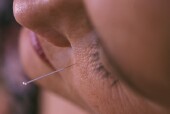
MONDAY, Jan. 9 (HealthDay News) — “Sham” acupuncture worked almost as well on migraine patients as three types of traditional acupuncture, a new study says.
Randomly assigning 480 patients to one of four groups at nine Chinese hospitals — one sham acupuncture group and three receiving accepted types — an international team of researchers, including Dr. Fan-rong Liang at Chengdu University in China, found that between 50 percent and 75 percent of those with migraines felt better after sham or real acupuncture, respectively, after 16 weeks.
Many prior randomized trials have supported acupuncture’s effectiveness in treating migraines, which affect up to 8 percent of men and 18 percent of women in the United States and England, according to background information in the study. But the researchers noted evidence is mixed on whether the treatment produces a placebo effect in patients or actually alleviates symptoms.
Some U.S. doctors, however, felt the bulk of the evidence strongly stands in acupuncture’s favor.
“I believe in acupuncture for pain,” said Dr. Gayatri Devi, an attending neurologist in the department of medicine at Lenox Hill Hospital in New York City. “I think it makes a difference, and while people really don’t understand how it works, the fact is that it does work. It doesn’t seem to matter how you put in the needles . . . I think as a treatment for pain, acupuncture should be embraced.”
The study is published Jan. 9 in the Canadian Medical Association Journal.
Participants, who ranged in age from 18 to 65, had experienced migraines for more than a year and had had two or three attacks in the three months preceding the study. All four groups received 20 treatments, including electrical stimulation therapy, over four weeks.
Patients in the three traditional acupuncture groups reported fewer days with a migraine in the four weeks after treatment than the control group, but the difference was minor, the study said.
In a journal editorial accompanying the study, Dr. Albrecht Molsberger of Ruhr University in Bochum, Germany, said acupuncture should be a first-line treatment of migraines along with other non-drug therapies such as biofeedback, cognitive behavioral therapy and lifestyle changes.
“It is at least as effective as [preventive] drug therapy, has longer lasting effects, is safe, seems to be cost-effective and reduces drug intake with possibly severe unwanted effects,” Molsberger wrote. “All of this can be achieved even if [acupuncture] point selection is not as dogmatic and precise as proposed by the Chinese system.”
Dr. Noah Rosen, director of the Headache Center at Cushing Neuroscience Institute in Manhasset, N.Y., said the frequency of acupuncture treatments in the study — averaging five per week — wouldn’t likely be replicated in the United States, where one or two treatments per week would be closer to the norm.
“What was interesting about this study was looking at the different styles of acupuncture and showing that the different styles were fairly equivalent to each other,” Rosen said. “One of the things that’s difficult for me is figuring out exactly how it applies to the care people receive in the U.S. . . . and that type of intensive treatment is rarely seen in my patients here. If we want to follow the model in this study, it would be very difficult time-wise and financially, I’m sure.”
More information
The U.S. National Center for Complementary and Alternative Medicine has more about acupuncture.

